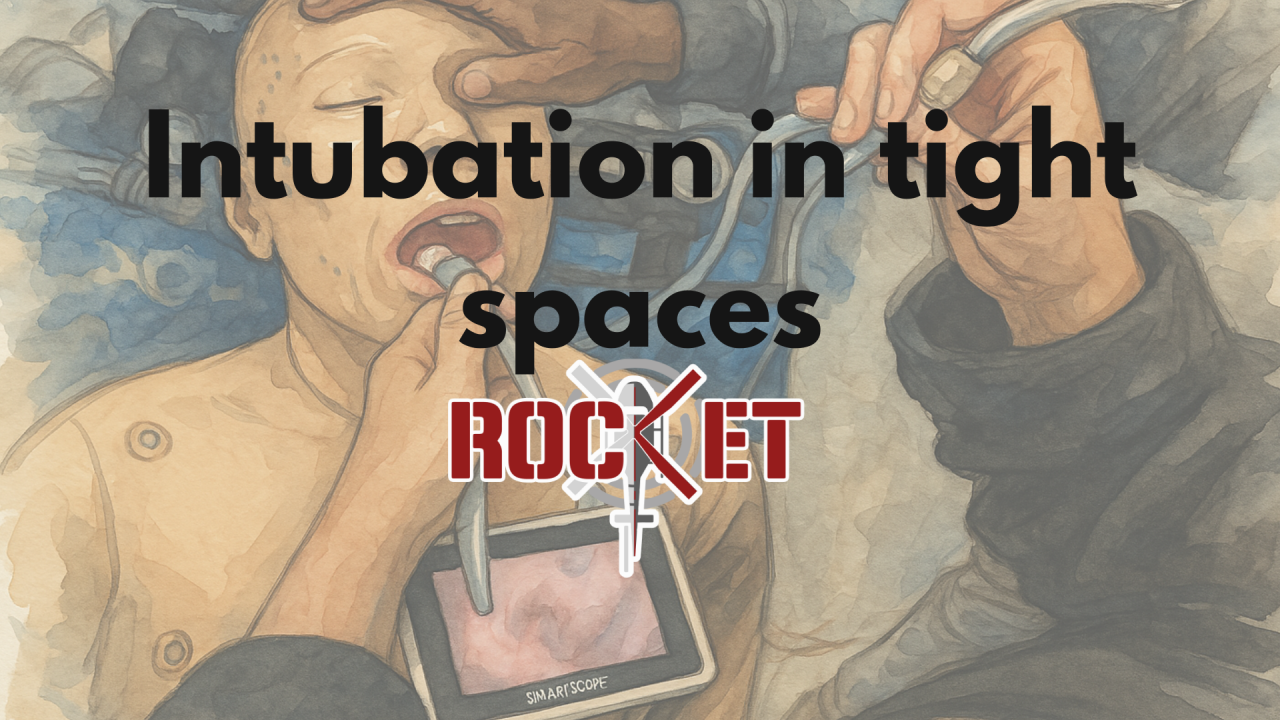Author:Â Kaleb Lachenicht, Director Epic EM and Chief Clinical Officer of ROCKET

We don’t often get to practice the worst-case scenario. Confined space. Limited light. Rotor blades turning overhead. The patients who need airway management in flight should be limited – and with good planning and preparation on the groun, these incidence should be far and few betwee. But – in the case that there is a need for advanced airway management in flight and the SGA is not cutting it – here is some information that might help you make better decisions for this incredibly difficult airway.
A very recent study from Germany (Warnecke et al., Air Medical Journal) brings evidence to a problem we face every day in HEMS: how to secure the airway when our patient is strapped in, and access to the head is awkward at best.
The paper looked at a few intubation options inside a simulated helicopter cabin. They tested the standard head-end approach, kneeling side-on, and the so-called “icepick” method—an approach where the clinician stands face-to-face and inserts the tube vertically.
Here’s the major learning point: the icepick method was the worst performer across the board.
đź”» What Went Wrong with Icepick?
Low first-pass success (FPS): Just 76.4% when done with direct laryngoscopy. Even with video laryngoscopy (VLS), success didn’t go beyond 78.2% on the first attempt.
Longer intubation times: Up to 34 seconds, compared to just 14.6 seconds for the best-performing alternative (kneeling sideways with VLS).
Ergonomic challenges: Tube delivery was the real issue. Even when the cords were visualised, bent tubes, bad angles, and awkward hand positioning led to failure.
Subjective difficulty: Rated hardest to perform—4.6/5 on average—and that didn’t improve much even after the attempt.
The icepick is always an option that comes up in our airway training, it looks cool and we imagine all the times this would be helpful. In reality, the swapover of the laryngoscope to the right hand, the mechanics and angles and the delivery of the the ETT with the left hand all culminate in a skill that is so different to the mechanics of the “normal intubation” that in increases the risk of failure – in an environment where failure is not an option!
This wasn’t just about skill. The study included both consultants and junior doctors. Interestingly, experience level made no statistical difference. The limitations were mechanical and positional—not cognitive.
âś… What Worked Better?
The kneeling side-on technique with video laryngoscopy came out on top:
94.5% first-pass success
Shortest average time to intubation
Better subjective confidence
Minimal esophageal placements
This is a technique that most HEMS clinicians can learn quickly, works even with moderate experience, and adapts well to our helicopter environment. The adaption of the “normal” position means that very little changes, and the skill mechanicaly at lest stays the same.
🧠Why This Matters in the South African Context
In our setting, the reality is that many of our patients are loaded laterally, intubated in tight spaces with equipment racked in tight corners. Our crews are diverse— with the vast majority being paramedics. We dont intubate very often (as much as we would like to think this is a skill that we are very good at).
The icepick method may look good on paper or in simulation rooms, but in real-world retrievals, it’s a risk we don’t need to take. This study reminds us: intubation isn’t just about seeing the cords—it’s about delivering the tube safely and fast.
Let’s keep pushing for simulation that mimics our actual aircraft. Let’s practise kneeling side-on. Let’s make sure every HEMS bag carries a reliable VLS system. And let’s share our wins and misses.
Finally, this study again reiterates the need for Video Laryngoscope as a BASIC piece of equipment required in all retrieval services. Without VL – we are not providing the optimal conditions for intubation. Our patients deserve the very best of what is available, especially considering how sick they are to start!
👇 TL;DR for Retrieval Clinicians:
❌ Don’t reach for the icepick—longer times, lower success, higher frustration.
✅ Kneel side-on with VLS—fast, reliable, and better tolerated in-flight.
🎯 Experience helps—but training in technique and positioning matters more.
🎧 VLS gives your eyes what your stethoscope can’t.
📦 We should be simulating these challenging scenarios often – simulation should match reality. This means straps, noise, vibration, heat or cold, and stress.
Got stories from the sky? I’d love to hear what works in your aircraft, what tools you’ve found reliable, and how we keep making airway management safer for our patients—no matter the altitude.
Reference: Warnecke, T., Schnackenberg, N., Hinkelbein, J., Klausen, A. and Kolaparambil Varghese, L.J., 2025. Airway management in the offshore rescue helicopter: Evaluation of tracheal intubation in alternative positions. Air Medical Journal, [online] Available at: https://doi.org/10.1016/j.amj.2025.03.001 [Accessed 5 May 2025].




